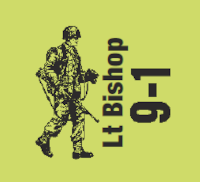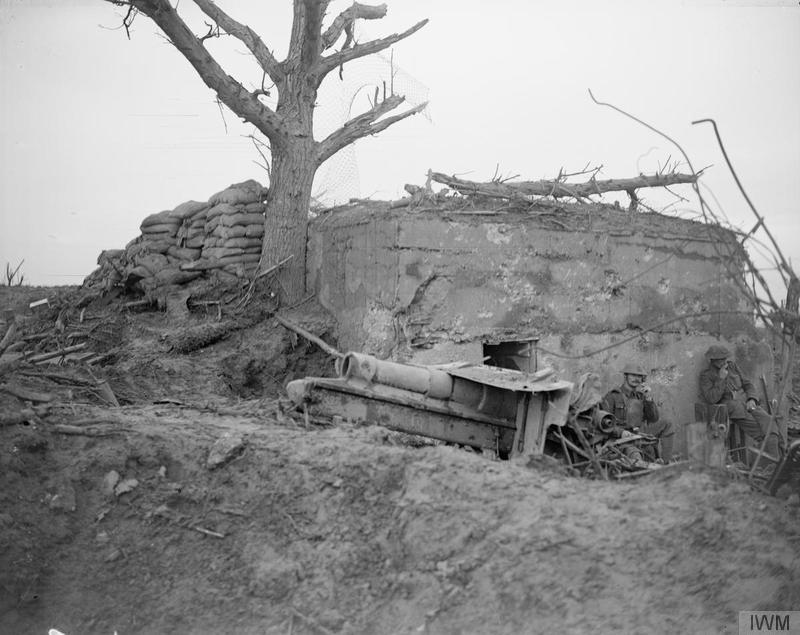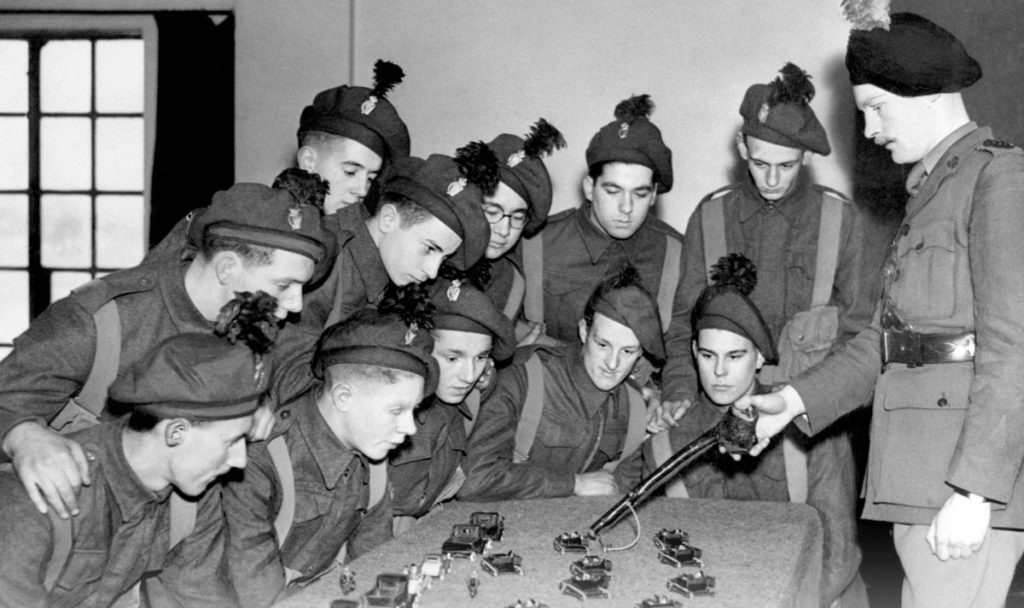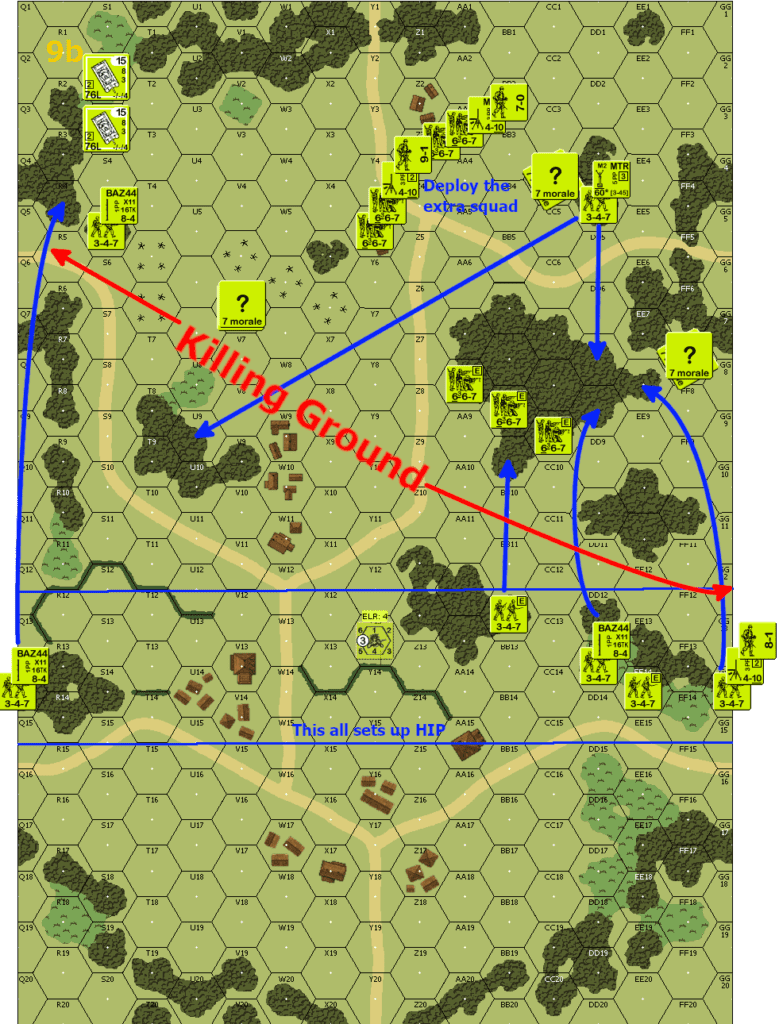
While working on the article covering Fortifications and Obstacles in ASL, I gave some thought to types of defenses in ASL. Sitting and thinking about it, I came up with five types of defense: area, point, defense in depth, mobile defense, and disruptive. Some of these seemed a little arbitrary to me, so I delved into doctrine.
I looked at period Field Manuals and contemporary literature trying to find something that resonated with my experiences in ASL. I found contemporary literature was the best corollary to ASL as I know it, but that literature covered battalion employments. Much of ASL is generally at the company and platoon level.
Still, my thinking was basically in line with the literature. This reassured I was on a good path. What follows is my thinking defense at a macro-level.
Defending is Programming?

I know a lot of ASL players come from a computer science background. Even amongst those who do not, there are a lot of players who can program. Among this crowd, the concept of “design patterns” should resonate. This is how I believe we should properly think about defense.
For those who don’t know, a design pattern is a general, repeatable solution to common programming problems. It isn’t the code necessary to solve the problem, but it is a way of easily resolving the problem by tailoring it to the requirement. With a toolbox of patterns, a programmer decomposes the problem into smaller tasks solved by specific patterns. Solving all the tasks also solves the problem itself.
Occasionally, a general pattern doesn’t fit a task. It is there the programmer must focus the bulk of their effort. But once completed, we add the pattern to the library and it is reusable later.
Defending Patterns

When setting up a defense, I start by examining the VC to understand the least I can do to win. This becomes my aim or the problem I am trying to solve. Knowing my aim, I examine the terrain to look for defensive tasks I can stitch together to meet these minimum requirements. In programming terms, I decompose the hard problem (the VC) into discrete tasks. Solving these tasks gives me a chance to resolve the problem and, therefore, win.
As we look at the defending patterns, keep in mind these are very general. They are not a script. It is incumbent upon the player to decompose the defense into a series of tasks and then identify a pattern to apply to the task. Identifying a pattern and applying the principles is not a matter of simple regurgitation. Effective application involves adapting the pattern to the local circumstance. The ideal solution will almost always be a combination of patterns. Do not forget that any pattern must be adaptable to consider the vagaries of extreme luck. You can control most aspects, but the dice will always betray you at the crucial moment. Never hinge your plan on a necessary series of rolls.
Also, these are my patterns. I am sure many will recognize them from their own play. There is nothing revolutionary (or even evolutionary) here. Some will suggest additional patterns. As with any topic, opinions will vary.
A Word Of Caution

Remember, before you proceed, you should have already examined the VC and terrain. You should have a general idea of a plan and know how you expect to win. These are prerequisites to what follows. A plan doesn’t magically appear by slapping a few patterns on the map. Patterns are part of the plan and must be integrated into a cohesive defensive posture designed to do the least amount necessary to win. I covered my thought process on this in my ASL Maxims article. I cannot emphasize this enough. Failing to plan is ensuring failure.
Strong Points

When I refer to Strong Points, I am referring to some cluster of terrain around which a defending “platoon” will be based. The Strong Point should enable the “platoon” placed here to fulfill the task–the defending pattern–assigned. This isn’t an Alamo, although it could be. The ideal Strong Point has positive TEM and a covered Location to rout to and rally in. Ideally, covered paths for ingress and egress from your side of the map exist with wide open fields of fire on the attacker’s side of the map. In a perfect world, Strong Points mutually support each other with interlocking fields of fire. Strong Points should also contain a rally position. The longer you plan to hold the Strong Point, the more instrumental the rally point is.
As I thought more about Strong Points, I realized I don’t use a “point defense” as alluded to in the first paragraph. I am actually using a Strong Point (or series of Strong Points) with some other design pattern mission applied, likely an Alamo or Choke Point pattern. As such, I removed “Point Defense” pattern from consideration.
Criteria For Strong Point Consideration
- What is the Strong Points mission?
- What pattern will we use?
- How long does the Strong Point need to be held?
- This is part of the pre-game analysis.
- What type of units/weapons will be in the Strong Point?
- This will be determined by the OB
- Are units in the Strong Point expected to fall back?
- Do they have a secondary mission?
- Do they need a secondary Strong Point?
- What is the trigger to fallback?
Tactical Considerations

When setting out to defend, there are a couple of tradeoffs to weigh. These are not mutually exclusive, but understanding your intent can help to focus your decision making. Remember, we are seeking to do the least possible amount of work necessary to ensure victory. In no particular order:
Enemy Disruption vs. Enemy Destruction
We all know what destruction is. Disruption doesn’t mean Disruption in an ASL sense, it means the units aren’t capable of fulfilling the attacker’s mission. An AFV blocked from achieving its mission by an A-T Ditch is disrupted in this sense. Broken Infantry is “disrupted” from completing its mission objectives. Sometimes destroying the enemy isn’t the aim. Knowing your intent can help set triggers to fall back or counter-attack as needed.
Area Denial vs. Terrain Retention
Preventing the attacker from using some key terrain, for instance, a hilltop or road, is important to the conduct of the defense. Of course, you could occupy this terrain and deny it that way, but maybe there is a better option. Maybe Mines can make the terrain less usable. Perhaps an OBA AR drifting in the area is enough. Maybe a Gun overlooking the area can do the job.
Force Preservation vs. Hold At All Costs
Sometimes, having troops left at the end is part of the VC condition. In those cases, we need to emphasize force preservation. Sometimes, simply denying the attacker the VC is all that matters. In those cases, remember, it’s only cardboard.
Disrupting Combined Arms Forces
Infantry (and Guns), armor, OBA, and air support combine to make the whole greater than the sum of its parts. One of the defender’s objectives has to consider how to break this synergy up. Stopping one or more of these aspects places a greater burden on the other arms. For instance, separating Infantry from supporting AFVs makes both more vulnerable. This subject is an easy thing to mention, but a hard thing to describe in action. As you learn, you’ll develop a sense for how this works. I am sorry I can’t give you a better insight than that.
Spoiling Attack Pattern
This is recognizing a local opportunity. As part of conducting the defense, an opportunity arises to counterattack. This may be an opportunity to surround broken units and eliminate them for failure to rout. Maybe the attacker allows units to push out into space, creating more breathing room for the defense. Much like disrupting combined arms attacks, recognition and exercise of this option will develop over time. It is hard to recognize opportunities and MUCH harder to plan for.
As you are planning your defense, keep these considerations at the forefront of your thinking. Now, let’s look at the patterns as I see them.
Defensive Patterns
Area Defense Pattern
This pattern denies the enemy usage of a tract of space on the map. This can be open ground the enemy needs to cross or terrain that needs taken. You can deny this space via firepower or obstacles. Mines placed in a key Rally terrain Location are just as effective as firepower for making this Location undesirable. The Defender’s aim is to make this terrain as costly as possible to take or cross. The attacker must pay the price in time and material.
Alamo Defense Pattern
This pattern holds a hex or a small cluster of hexes. Usually this will be a “hold at all costs” effort. Presumably, this represents the least the defender can do to win. Often, the Strong Point is the Alamo. It is essential the Defender knows how VCs are achieved or denied. Imagine a building Control scenario. It is the last turn, and the Attacker is Adjacent and capable of entering CC. Voluntarily breaking and routing to an upstairs location may be enough to win.
Defense in Depth Pattern
This is a multi-layered pattern of mutually supported Strong Points. This defense seeks to invite the attacker into the spaces between Strong Points and then destroy the attacker from all sides. This might backfire as the attacker can seek to cut off and reduce Strong Points one at a time. A key element of this defense is to DELAY the attacker at every opportunity. This pattern is likely composed of many other patterns. This pattern synergizes very well with the Area Defense Pattern.
Linear Defense Pattern
This pattern is the opposite of a defense in depth pattern. The Strong Points in this pattern are in a line perpendicular to the enemy attack. This pattern is best suited to oppose Infantry assaults. A mobile enemy that penetrates the line will be nearly impossible to deal with. We can predicate the Linear Defense on a board edge, a ridgeline, a road, a gully/stream, or any other linear terrain feature. The ideal implementation offers good TEM for defending units while subjecting enemy units IFT DR with negative modifiers. A proper Linear Defense will also have some local reinforcements to plug holes in the line. This pattern synergizes very well with a Fighting Withdrawal pattern.
Fighting Withdrawal Pattern
Characterized by a series of tasks designed to delay and wither away the attacking force. Usually, the Defender is trading space (ground) for time. Sometimes, the Defender must also fulfill an exit requirement. The initial tasks (and associated Strong Points) are likely on the front line and part of a Linear Defense or Defense in Depth pattern. Subsequent tasks (and associated Strong Points) are behind the front line. The defender plans to fall back in his turn to reform the line. Each new line is likely to follow a Reverse Slope pattern. The key to this pattern is recognizing when it’s time to fall back to the next line. Rout paths, skulking positions, and Rally Locations are keys to success.
Mobile Defense Pattern
Units moving to the point of attack rather than being set up to receive the attack characterize this pattern. This has the benefit of defending the point of attack but carries the risk of being interdicted traveling to the point of attack. These moving units can be a local reserve carved out of the Defender’s OB, or reinforcements brought onto the board after the game begins. Usually, units taking part in a “Mobile Defense Pattern” will move to Strong Point and enact one of the other Defensive Patterns.
Disruptive Defense Pattern
Random placement of units which intend to disrupt the attacker’s continuity and timeline characterizes this pattern. This pattern forces the attacker to spend time and resources to reduce the problem. HIP Obstacles or units popping up to take unaccounted for shots are great examples of this pattern. We can also use careful employment of a mixed force of Concealed units and Dummy Stacks for this pattern. Doing so will help sew confusion and doubt in your opponent’s thinking.
Reverse Slope Pattern
Hiding behind some terrain to avoid incoming fire. This pattern takes its name from setting up a defense on a hillside opposite the attacker’s advance. This pattern also ensures the defender takes the first shot. The goal is to break or eliminate the attacker every time he advances into LOS. Ideally, the defender has better TEM/protection than the attacker on the hilltop. It is best if the defender has something at the level of the hilltop to strip concealment from units advancing up into open ground. This pattern synergizes very well with the Linear Defense Pattern.
Perimeter Defense Pattern
We characterize this pattern by an all around defense. Typically, squeezing the bulk of the defender’s OB into a small space arrayed to defend in all directions. We often use this pattern when Strong Points are far enough apart that units in them cannot effectively support each other. Units committed to this pattern are highly likely to be eliminated. If survival is key, either do not commit units to this pattern or withdraw them to a secondary task quickly.
Choke Point Pattern
This pattern is best used when the enemy has few options for fast movement into the defense. The goal is to identify narrow passages and then deny the attacker’s usage of these passages. This is often best accomplished when terrain is available on either side of the passage, allowing the defender to cross fire on units attempting to force their way through. The “width” of the passage should be no wider than the effective engagement range of the units attempting to hold the passage. Set Strong Points on either side of the passage and hold as long as necessary.
Ambush Pattern
This pattern is characterized by having more units covering the ground than the attacker perceives. Careful usage of Dummy stacks and hidden units are a key aspect of this pattern. Long-range fire from elevated units can sometimes contribute in unexpected ways. The canonical example is a hidden Gun or half squad with a bazooka popping up to kill an enemy vehicle. But there are plenty of other options. For instance, a Pillbox and all its contents set up hidden. We do not place the Pillbox and its contents on board until an enemy unit gains LOS (LOS at ≤ 16 hexes if in Concealment terrain). This can lead to some nasty surprises.
Patterns And Toby Pilling’s “Manual”

For a moment, Let’s consider Toby Pilling’s excellent article, A Players Guide to A SeLf Defence from Le Franc Tireur #11. In his article, Toby says “I split the OB into platoon-sized forces” and these platoons “give(s) me the number of defensive positions”. Toby speaks about how he divides up unassigned Infantry, leaders, and support weapons based on the tasks he has assigned each platoon.
What I do is something quite similar. First, I examine the VC to determine the least I can do to win. I examine the terrain to decide the best chance to achieve this “least effort solution.” Next, I try to determine the enemy’s path to the VC I intend to deny, looking for defensible areas to achieve my victory. I identify Strong Points along this path and determine if there is a defensive pattern suitable to the terrain and forces I have on hand. Finally, I assign the forces I have to the task, adapted to the terrain and VC.
I find it VERY interesting that Toby and I have independently arrived at a similar approach. All credit to Toby’s article for making me write this all down.
An Example
I recently played DB169 Sternbeck’s Sortie from Dispatches from the Bunker. I was playing defense. Before laying out a plan, I examined the scenario card and terrain under my ASL Tactical Maxims. This examination resulted in the following observations:
- I only needed to hold one building to win
- I could also win by gaining ≥ 35 CVP
- There are 39 total CVP of AFVs in the German OB
- The M10 GMC has a Base TK # of 17, easily able to defeat German armor
- They also have a ROF of 2
- One M10 sets up HIP and can be used for an ambush, potentially bagging multiple German AFVs
- Two BAZ also setup HIP and might ambush German armor
- German mobility exceeds my own
- A Linear pattern will not work
- Sadly, setup instructions dictate units set up in up front locations
- These units will have to conduct a Fighting Withdrawal
- Will not work if the Germans aggressively push his armor on turn 1
- Because of German mobility, I must conduct a Defense in Depth
- Absorb the attack into the heart of my defense
- Whittle away his Infantry so he cannot take buildings
- Kill AFV where I can to put a strain on the CVP cap
My analysis covered more than I present here but I don’t want to do a full scenario review within this article. Suffice it to say, I developed an idea of each side’s strengths and weaknesses. From there, I decided which piece of the German VC I could deny my opponent with the least amount of effort. I then identified Strong Points and deployed my units accordingly. The image below shows my initial thoughts.

Initial Plan
This next image shows the actual implementation of my plan.

A couple of notes about this plan:
- I pegged my win to holding Z2/Z3
- Either makes me the winner
- I also have ambush opportunities to threaten the CVP cap
- This should slow the Germans down some
- Everything between the blue lines sets up Hidden per SSR
- The blue “curved” arrows show my fall-back plan
- The most critical move is the 8-1/MMG/HS combo, who must get back to woods mass to provide a leader for that Strong Point
- Concealment counters are representing the one remaining GMC which sets up on board
- I am hoping to sew a little doubt in my opponent’s mind
- The fact the Hidden and REAL GMC are side by side should be a surprise
- The M10 GMC in S3 is also Hidden
- The GMC are there to provide fire support along a line from Z8 to CC12
- The woods mass around CC7 is potentially a die to the last man Strong Point
- Getting through Open Ground with this much firepower will be hard
- Fire lanes can make movement even more restricted
- The BAZ falling back to DD8 needs to be in a place to cover ground not covered by the GMCs
- This fallback is not written in stone
- This HS does have to hide from German Infantry
A Last Word

So there we have it. How I think about defense in a few short pages. If you have read Toby’s excellent article, you should be able to see remarkable similarities in our approaches. Identify locations to defend from. Assign units to those locations. Divvy up SW. And then wait for the enemy.
Although Toby didn’t mention it in his article, I would venture a guess he is even semi-thinking about many of the same things I highlight here. I think most good players think like this on at least a subconscious level. It wasn’t until I read Toby’s article that I even tried to put my approach into words.
If you have a look at the scenarios I have analyzed on my blog, you will see many of these ideas embodied in those analyses. Even as I was writing those articles, the ideas brought forth here are pervading through those articles. I will use the terms in this document in the future as I continue to write more scenario analyses
A Word Of Thanks!
I would like to thank several unsung heroes. First, Toby Pilling without whose article I never would have thought to put this into words. David Garvin and HongKongWargamer took an early version of this article and helped me to better focus on the final product. Andy Hershey helped refine the second version. Finally, Mike Balis, Michael Hastrup-Leth, and Martin Vicca reviewed the 70% solution and provided me with some excellent suggestions for the final product. Mike Balis was kind enough to read it one last time before I pressed publish. I alone remain responsible for any errors, but this product wouldn’t be what it is without their help. Thanks, guys.
Until next time. – jim


>>When setting up a defense, I start by examining the VC to understand the least I can do to win.<<
I like this approach! It never occurred to me to think of defending along these lines.
It pays to be lazy. 🙂 — jim
I love the comprehensive & yet concise listing of defensive patterns. The example at the end really ties it all together. I am taking detailed notes just to help me remember.
I doubt it is comprehensive. I am sure there are some missing. For instance, I have used an “Anti-Air” pattern to shoot down and enemy aircraft before.
On Facebook, I mentioned I played this scenario the day before I posted this. I finished the plan and wrote it up before playing. After playing, I noticed I also employed a Choke Point/Ambush pattern as I played. At this point, much of this is subconscious for me now so it was a particularly hard article to write down. This means there are other patterns floating around in my head.
I am pleased you like though. Thanks for the interest and feedback.